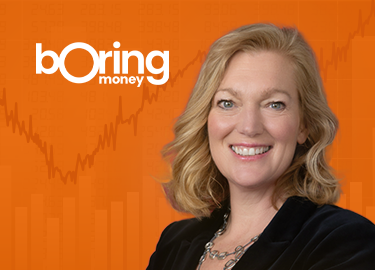Holly Mackay founded Boring Money in 2015, an independent investment website. With over 25 years of industry experience since graduating from Oxford, she’s a two-time Investment Woman of the Year winner, a regular media commentator and a serial entrepreneur, selling her first business in 2014. Holly’s mission is to help ‘normal people’ to understand investments, frequently appearing on major news networks and writing for national publications.
Some people dread turning 30, seeing it as the step from ‘being young’ to a time of greater responsibilities. Our 30s can be a brilliant time of change and exciting new chapters – whether that’s advancing in our careers, building meaningful relationships, finding our ideal living situation, or choosing to start a family. So what does this mean for our money?
All of these changes mean we face more decisions about our money, trying to juggle limited means with a growing list of wants and needs. While you may be earning more now than you were in your 20s, the cost of flats, weddings (yours, or just your friends!) and maybe babies is daunting for everyone.
We’ll explore three critical financial milestones you may face in your 30s: how to maximise your investment strategy, manage money as a married couple, and build a secure financial foundation for your children.
1. Maximising your investing potential
First and foremost, avoid “lifestyle creep”
As you enter your 30s, career progression can often (and hopefully!) bring salary increases. However, with more money comes the temptation to spend more – this is known as “lifestyle creep”. It’s easy to upgrade your car, move to a pricier home, or dine out more often without realising that these incremental changes eat into your ability to save and invest for your future self.
While enjoying your hard-earned income is important, maintaining a balance is also crucial. Rather than allowing expenses to rise in line with earnings, consider channelling a sensible portion of every pay rise into your savings and investments first, ensuring your financial future benefits alongside your current lifestyle.
A good rule of thumb is to increase your savings and investing rate in proportion to salary growth. Let’s say you receive a 10% pay rise; perhaps try to boost your pension contributions, ISA investments, or other long-term savings by at least half of that increase before adjusting your spending habits. This way, you’re improving your long-term financial security without feeling deprived today.
Understanding risk and which account to use
Your 30s are also a great time to start thinking seriously about what’s known as your ‘risk appetite’ when investing – essentially, how much volatility you are prepared to accept to try and maximise your longer-term gains.
The answer to this question depends on which ‘savings pot’ you’re thinking about.
For any pension you have (whether through work or one you set up yourself), with decades ahead before retirement, you’ve got the advantage of time on your side, which can help smooth out the ups and downs of the markets. This means you might feel more comfortable taking on riskier investments like shares, which have historically delivered better long-term returns compared to cash or bonds.
Even though we may have other more immediate needs for our money in our 30s, read up on your workplace pension. Some companies will match any additional pension contributions you can make – so if you pay in an extra 1%, for example, so will they. If your firm offers this, it’s well worth considering and will probably be the most effective thing you could do to turbo-charge your retirement savings.
For other investments, which may be saving for something a bit nearer-term, you may want a less volatile approach. For example, if saving for a flat deposit, and you hope to buy in a few years, then cash is arguably a better bet because you’d be very vulnerable if stock markets had a downturn just when you need to cash in the money and take it for that deposit. If however this is realistically at least 5 years away, you may want to consider having some allocated to shares, to get exposure to potentially better returns.
Ask yourself how you would feel if your investments dropped by 10%, 20%, or even more. Some people can ride out market swings without breaking a sweat, while others might struggle to sleep at night. If you’re in the latter camp, you may want to lean towards a more cautious strategy with lower-risk assets such as cash and bonds.
Generally speaking, a low-risk investment strategy tends to give you smaller gains, but with less risk of volatility and thus a smaller chance of losing money. These strategies typically map better to shorter timeframes, of a few years. Whereas a high-risk investment strategy has the potential for bigger gains but also carries a greater risk of rapid ups and downs. So investing 100% in shares, for example, is usually only advised for those with a timeframe of five years or more.
Finally, let’s talk about the golden rule of investing: diversification. Spreading your money across different types of investments (assets like shares, bonds and property, or even different geographical regions) can help reduce risk without putting the brakes on potential growth. One very topical example is the dominance of just a few tech stocks in the US. We should all consider having as broad a mix as possible, avoiding having too many eggs in one basket.
Make sure you’re investing tax-efficiently
For investors in their 30s, using an Individual Savings Account (ISA) is generally a no-brainer when it comes to keeping your tax bill as low as possible. ISAs allow you to shield your investments from Income Tax, Capital Gains Tax, and Dividend Tax, meaning more of your hard-earned money stays in your pocket.
By this stage in life, some investors will have started to build up a decent-sized portfolio, and as it grows, so do the potential tax implications. Without the shelter of an ISA, gains over the annual Capital Gains Tax allowance (£3,000 for 2024-25 tax year) or dividends exceeding the Dividend Tax allowance (£500 for the 2024-25 tax year) could leave you facing an unexpected bill. An ISA takes that worry off the table altogether as any gains are protected from the taxman.
What’s more, the earlier you take advantage of your annual ISA allowance (currently £20,000), the greater the tax-free growth and compounding potential over time. For someone in their 30s, that’s a valuable head start. It’s particularly helpful if you’re investing in higher-growth assets like shares, which tend to generate larger gains over the years. By using an ISA, you’re future-proofing your portfolio against rising taxes or a growing tax burden as your investments expand.
For those under 40 who are committed to saving for a first property, it’s worth reading up on the Lifetime ISA. You can pay up to £4,000 a year into this tax-free account, with a £1,000 boost from the Government. There are lots of terms and conditions – including a penalty if you change your mind and need to access the money – so do your reading.
2. Managing your marital finances
Do you need a prenup?
With so many of us tying the knot in our 30s, it makes sense that the question of how to combine (or not combine) your finances should spring up, and romantic conversations about prenups are increasingly common. After all, they’re not just for the super elite or Hollywood golden couples.
If both or either party has a significant amount of wealth or assets, you may decide that a prenuptial arrangement is a sensible way of preparing for the unfortunate event of a breakup. Though you may already have a clear idea of how to separate your assets if this should come to pass, you may want some guidance on how to put things in writing. This is where a qualified financial adviser or a lawyer is best placed to help you and your partner make arrangements that suit both parties and can be executed as painlessly as can be, should the prenup ever be actioned.
Decide on joint banks accounts (or not)
Some couples may opt for the traditional route of a joint bank account, or you may feel more comfortable keeping things separate. Though choosing a joint bank account is the default move for many, it may not be the best choice for your relationship. For example, if you or your partner has a poor credit history, opening a joint bank account will lead to you being “co-scored” by credit rating agencies – so you may want to consider carefully if combining your accounts is appropriate.
Though making changes to improve your credit score is the obvious first step, you might be comfortable keeping your finances separate until you both have good scores.
Consider your pensions
Pensions are seldom at the top of the to-do list when you and your partner say “yes!”, but if you’re in your 30s, it’s the perfect time to sit down and take a good look at your pensions and retirement savings strategy.
While retirement might feel a long way off, the earlier you start planning as a team, the easier it will be to build a comfortable future together. Begin by checking what each of you has already saved – dig out those workplace pension statements and see how much you’re both contributing. This is also a good opportunity to review whether you’re taking full advantage of employer contributions, which can significantly boost your retirement pot without you having to lift a finger.
As a couple, it’s also worth discussing your shared goals and how your finances align. Are you aiming for an early retirement, or do you want to save enough to travel the world when the 9-to-5 grind is over? Understanding your ambitions will help you decide how much to save and what level of investment risk you’re both comfortable taking along the way. It’s also smart to think about balancing your contributions – if one of you is earning less or taking time out for childcare, for instance, the other might need to save a bit more to keep things on track.
Tax tips
If you are getting married and one of you earns less than the Personal Allowance (usually £12,570), the Marriage Allowance lets you transfer £1,260 of your Personal Allowance to your husband, wife or civil partner. This can reduce their tax by up to £252 in the tax year (6 April to 5 April the next year). You can learn more on HMRC’s website.
3. Preparing for your children’s future
Invest on your kids’ behalf
If you’re in your 30s and have children, setting up a Junior ISA (JISA) is a brilliant way to start building a financial cushion for their future. With a JISA, you can save or invest up to £9,000 per year tax-free on their behalf, giving their money a headstart thanks to the power of compounding.
Although the parent or legal guardian needs to set this account up, anyone can pay into it. This is a brilliant way to suggest that any obliging grandparents or relatives might be able to help, rather than buying endless babygrows and other gifts which will make your flat seem even smaller than it is once a baby arrives!
Even small, regular contributions can add up to a substantial sum by the time they turn 18 – all without the drag of taxes on gains or income you might face outside an ISA. If you save £20 a month for 18 years, and assume average returns of 5%, that would be a savings stash of around £7,000.
Just remember once they turn 18, the account automatically converts to an adult ISA and puts them in control.
Get extra help in the meantime
Investing and Junior ISAs aside, you may be more interested in the immediate concern of covering school fees and paying for the various extras that come with them – uniforms, sports equipment, and the like. There are lots of services out there that can help you plan for and around your kids, from handy budgeting apps like Emma and Plum to grants towards uniform and transport costs.
Programs like Tax-Free Childcare can contribute up to £2,000 a year per child to cover childcare costs, while eligible families may benefit from the free 15 or 30 hours of childcare for children aged 9 months to 4 years. It’s also worth checking whether you qualify for Child Benefit or additional support through Universal Credit, which can provide help with day-to-day expenses.
Parents should also look into local grants and discounts that might be available through councils, schools, or charities. These could include help with school meals, funding for extracurricular activities, or one-off payments for essential items like clothing or school supplies. Try the government’s calculator for help with childcare costs or get in touch with your kids’ school to start your research.
This communication is for information and education purposes only and should not be taken as investment advice, a personal recommendation, or an offer of, or solicitation to buy or sell, any financial instruments. This material has been prepared without taking into account any particular recipient’s investment objectives or financial situation, and has not been prepared in accordance with the legal and regulatory requirements to promote independent research. Any references to past or future performance of a financial instrument, index or a packaged investment product are not, and should not be taken as, a reliable indicator of future results. eToro makes no representation and assumes no liability as to the accuracy or completeness of the content of this publication.
eToro is a multi-asset investment platform. The value of your investments may go up or down. Your capital is at risk.






